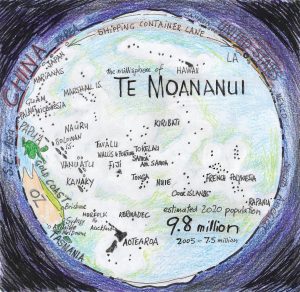
A Samoan geographer once said about the island nations of the Pacific that “The rest of the world sees us as islands in a far sea; we see ourselves as a sea of islands.”
The ‘millisphere’ is one ‘lens’ through which to look at the Pacific. By my definition a ‘millisphere’ is the ‘the sphere of interest’ of roughly one thousandth of the world’s total population. By this analysis we are looking for entities of roughly eight million people, let ‘s say less than four million is too small and over sixteen million too big.
By this standard Aotearoa/NZ fits, (five million, 2020) but all the other Pacific island nations are too small. By adding them all to NZ we get a total population of roughly ten million – and the millisphere I call Te Moananui. (It is estimated that the population of Te Moananui will be nearly ten million by 2020).
What then are some of the characteristics of Te Moananui? 500 years ago, when Magellan was the first European to sail across the Pacific, one language covered the largest area of any language group on earth. Whether it was aloha, alofa or aroha, the word for love could be understood from Hawaii to Tonga and Aotearoa.
The indigenous flora and fauna of Te Moananui had developed in isolation and the effects of introduced species were profound, and irreversible. Historical nuclear testing and dumping, predatory fishing practices on a vast scale, the accumulation of floating plastic pouring out of the industrialised ‘Pacific rim’ and sea-level rise from climate change are some of the unique environmental issues facing Te Moananui in the new millennium; problems that have their making in the rest of the world but impacting on Te Moananui.
The American travel writer Paul Theroux, who lives in Hawaii, covers some of the human geography of Te Moananui in his book ‘The Happy Isles of Oceania’. One characteristic is that many of the people go elsewhere for work. Former US president Barak Obama, from Hawaii, was one notable example; Tongan/English basketball player Steven Adams is another, and there are now Polynesian players in most American NFL teams. One in five New Zealanders are currently working overseas, primarily in Australia, and whereas Auckland is the world’s largest Polynesian city, now there are significant Polynesian populations, both Maori and Pacific Island, in Los Angeles, Brisbane, Sydney and Melbourne. Remittances back constitute an important part of many island states’ economies.
Te Moananui is made up of over twenty independent states, protectorates and territories – and one state of the United States of America. The Pacific Island Forum, which has observer status at the United Nations, is one emerging governance entity; with the potential to manage the $6 billion dollar plus annual tuna fishing industry, for example. The appointment of the ex-Labour MP, Shane Jones, as an economic development ambassador to the Pacific, recognised the growing importance of the Forum.
When Hone Harawira was still in parliament a delegation from Rapanui (Easter Island) met with him, calling for separation from Chile and monetary union with NZ and in Hawaii some native Hawaiians fly the flag upside down as a protest against the continuing American occupation following the Dole coup of 1894, which ended the rule of the Hawaiian Kamehameha royal family.
The NZ geographer Kenneth Cumberland, in the seventies, described the Pacific as “an American lake.” This is reinforced today with American super-bases in the Pacific – primarily world’s largest ‘gas-and-go’ military arsenal on the island of Guam and the whistle-blower, Edward Snowden, revealed the importance Pearl Harbour in Hawaii as a “five-eyes” cyber-spy base.
One of the last things George W Bush did before leaving office was to create the world’s largest fishing reserve in the Mariana Trench, near Guam. Laying claim to the deepest part of world’s oceans naturally appeals to American exceptionalism; but were the Pacific Island Forum members ever consulted?
In the1980s David Lange’s Labour government declared New Zealand “nuclear free.” The American position, that they would “neither confirm nor deny” if their ships carried nuclear weapons lead to a thirty year standoff between the USA and NZ. It was resolved with the pragmatic “don’t ask” position taken by John Key’s National government in 2010.
